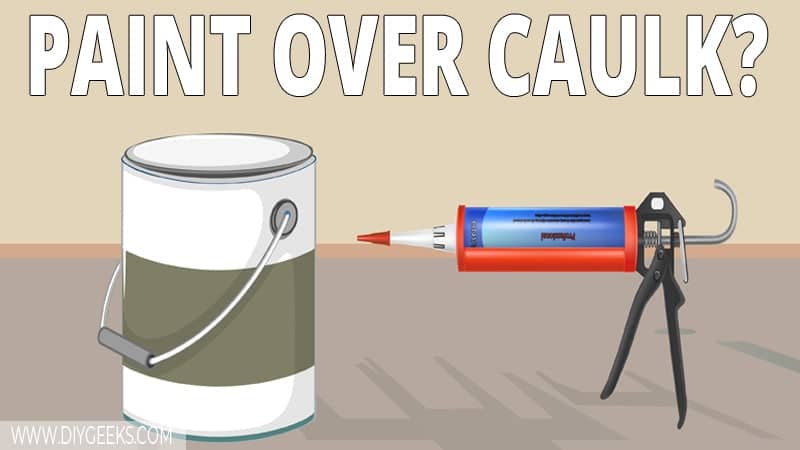You can paint over paintable caulk types, but you can’t paint over non-paintable caulks often made from silicone compounds.
To paint over caulk, clean and sand the caulk, apply primer and paint.
The caulk must dry for around 24 hours before painting over it. If you paint over it too soon, it creates a sticky and wet finish that can peel off.
Does Paint Adhere to Caulk?
Paint does adhere to paintable caulk made from cotton fibers, acrylic compounds, and other paintable materials. These caulks are designed to be compatible with paints, allowing a smooth finish.
However, paint doesn’t adhere to non-paintable caulks that often contain silicone compounds. Non-paintable caulk doesn’t allow paint penetration or adhesion as they are formulated with protective additives to make their surface moisture-resistant.
If you paint over paintable caulk, the paint penetrates the caulk surface and forms a colorful and durable finish. If you paint over non-paintable caulk, the paint can’t penetrate the surface and remains wet for longer until it peels off.
Most paints are penetrating finishes and need to penetrate the surface pores to adhere. If the paint can’t penetrate surface pores, it won’t adhere and will peel off.
To know if a caulk is paintable or not, check the label or product information.
How Long Must Caulk Dry Before Painting?
The caulk must dry for around 24 hours before painting over it. Once it dries, it becomes hard (rigid) enough to support a paint coating.
The exact dry time depends on the caulk type and the ambient temperature. For instance, acrylic or latex caulk dries faster than exterior or polyurethane caulk.
If you paint too soon, the paint won’t adhere properly and will create a sticky finish that prevents the caulk and paint coating from drying.
How To Paint Over Caulk?
To paint over caulk, do the following things.
- Clean the Caulk.
- Sand the Caulk.
- Apply Primer.
- Apply Paint.
The tools you need for this project are listed below.
- Fine-grit sandpaper
- Primer
- Denatured alcohol
- Paint
- Paintbrushes
- Rags
1. Clean the Caulk
Clean the caulk with denatured alcohol to remove dirt, dust, debris, and stains that can prevent proper paint adhesion.
If the caulk is new, you don’t have to clean it with denatured alcohol. Simply clean it with a dry rag to remove dust or debris.
2. Sand the Caulk
Lightly sanding the caulk with extra fine-grit sandpaper (440-grit) can enhance paint adhesion. However, this isn’t necessary for new or high-quality paintable types.
3. Apply Primer
Most paintable caulks don’t require a primer coating, but applying it can enhance the paint adhesion. Simply apply one (1) thin latex primer coat and allow it to dry.
4. Apply Paint
Apply 2-3 thin paint coats over the caulk using a paint brush or roller. Wait until one coat dries before applying the next one.
It’s recommended to apply thin paint coats as thick coats don’t adhere properly and can create a sticky finish.
Use exterior paint for exterior caulk as they are generally applied outdoors and need better protection.
Seal the paint finish with exterior polyurethane to increase its durability and resistance to moisture or water.
How To Prevent Caulk Cracks When Painting Over It?
To prevent caulk cracks when painting over it, do the following things.
- Apply thick caulk coats.
- Apply thin paint coats.
- Seal the surface holes before applying it.
- Wait until one coat dries before applying the next one.
A caulk finish cracks if you apply thin coats of it. So, once you paint over it, the thin coating will crack due to the extra weight.
Can You Paint Over Different Caulk Types?
- Decorator’s Caulk: You can paint over decorator’s caulk as it’s made from materials such as cotton fibers that accept paint penetration and adhesion.
- Acrylic or Latex Caulk: You can paint over acrylic or latex caulk as it contains additives that are compatible with paint.
- Polyurethane Caulk: You can paint over polyurethane caulk if you sand and apply a primer coating first.
- Builder’s Caulk: You can paint over the builder’s caulk.
- Wet Caulk: You can’t paint over wet caulk as it creates a weak sticky finish that will crack eventually.
- Silicone Caulk: You can’t paint over silicone caulk as it contains silicone compounds that prevent proper paint penetration or adhesion.
- Flex Seal Caulk: You can’t paint over Flex Seal caulk as it contains additives that prevent paint adhesion and penetration.


